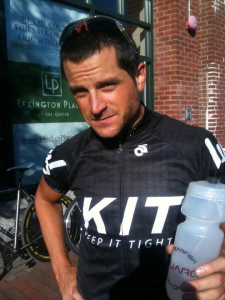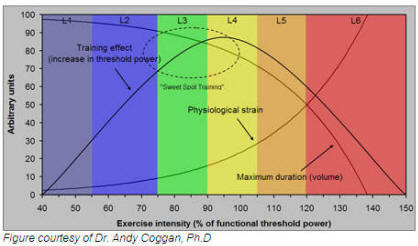By guest KIT blogger, Cort Cramer
The winter is quite cold for many of us here in the US,  and as a result a portion of your training time will very likely be spent on the indoor trainer. The indoor trainer can provide focused and high-quality training sessions, as typical outdoor distractions (cars/wind/hills/etc.) are mitigated.. Once you have committed yourself to riding indoors, you must carefully consider the types of sessions to do. See below for two types of indoor trainer workouts.
and as a result a portion of your training time will very likely be spent on the indoor trainer. The indoor trainer can provide focused and high-quality training sessions, as typical outdoor distractions (cars/wind/hills/etc.) are mitigated.. Once you have committed yourself to riding indoors, you must carefully consider the types of sessions to do. See below for two types of indoor trainer workouts.
CADENCE-BASED SESSIONS
Cadence-based workouts emphasize changes in cadence instead of power and heart rate. Cadence-based workouts typically do not stress the cardiovascular system, but are more focused on improving the muscular system and can range from high rpm efforts emphasizing neuromuscular power to very slow rpm efforts emphasizing muscular strength. The higher cadence sessions help to ensure that you maintain your ability to quickly contract and relax the muscles over the winter, a crucial skill in cycling. Indoor sessions for these are relatively simple, and can easily be performed outdoors also when weather permits. A standard session of this type would be fast pedaling intervals: pedal one minute at ≥110rpm, followed by one minute at your self-selected (i.e. “normal”)cadence, then repeat. This is a great “leg burner,” but should not significantly elevate heart rate or become anaerobic in nature.
Similarly, lower cadence sessions are beneficial to perform as they enhance muscular strength, which allow for improvement of peak sprint wattages and the ability to push a larger gear into the wind. Muscular strength sessions are built around hard, short intervals performed in a large gear which you can manage at low rpm. A standard session of this type would be spin ups. Shift into your 53:12 or 53:11, slow down to about 8-10mph and, while remaining seated, tighten your core, grip your handlebars tightly and with all of your force turn the gear over until you reach 80rpm (once you have reached 80rpm, the amount of force being applied to the cranks has reduced to a point at which it is just not enough stress to create muscular strength improvements); spin an easy gear for a minute or two at your self-selected cadence, and repeat. You should plan on doing approximately twenty of these low cadence bursts in one session in order to create enough of an overload to achieve some benefits.
SWEET SPOT TRAINING SESSIONS
Sweet Spot Training (SST), defined as approximately 88-93% of one’s Functional Threshold Power (FTP), is another type of training to consider as part of your winter programme. If you examine the graph below, you can observe that SST is a balanced amount of volume and intensity that produces a maximal increase in an athlete’s FTP. When you are riding in this area of intensity, the level of physiological strain is relatively low, while the maximal duration that you can ride in this area is quite high, giving you a tremendous “bang for your buck.” When you do SST, start out with 15-30 minute efforts, and gradually build up to 60-120 minute efforts, if possible. Be sure to do one or two of these sessions per week, and you’ll see a big difference in your FTP come February.

Figure courtesy of Dr. Andy Coggan, PhD.
A properly executed winter training regimen will elevate your FTP to that next level, maintain your ability to change cadences and ensure you arrive at the start of the 2012 racing season with a fresh body and rejuvenated mind prepared for the season ahead. Keep your focus this winter and make 2012 your breakthrough season!
*Cort Cramer, M.S. is USA Cycling Level 2 certified and Associate Coach at Peaks Coaching Group.
Sorry, the comment form is closed at this time.